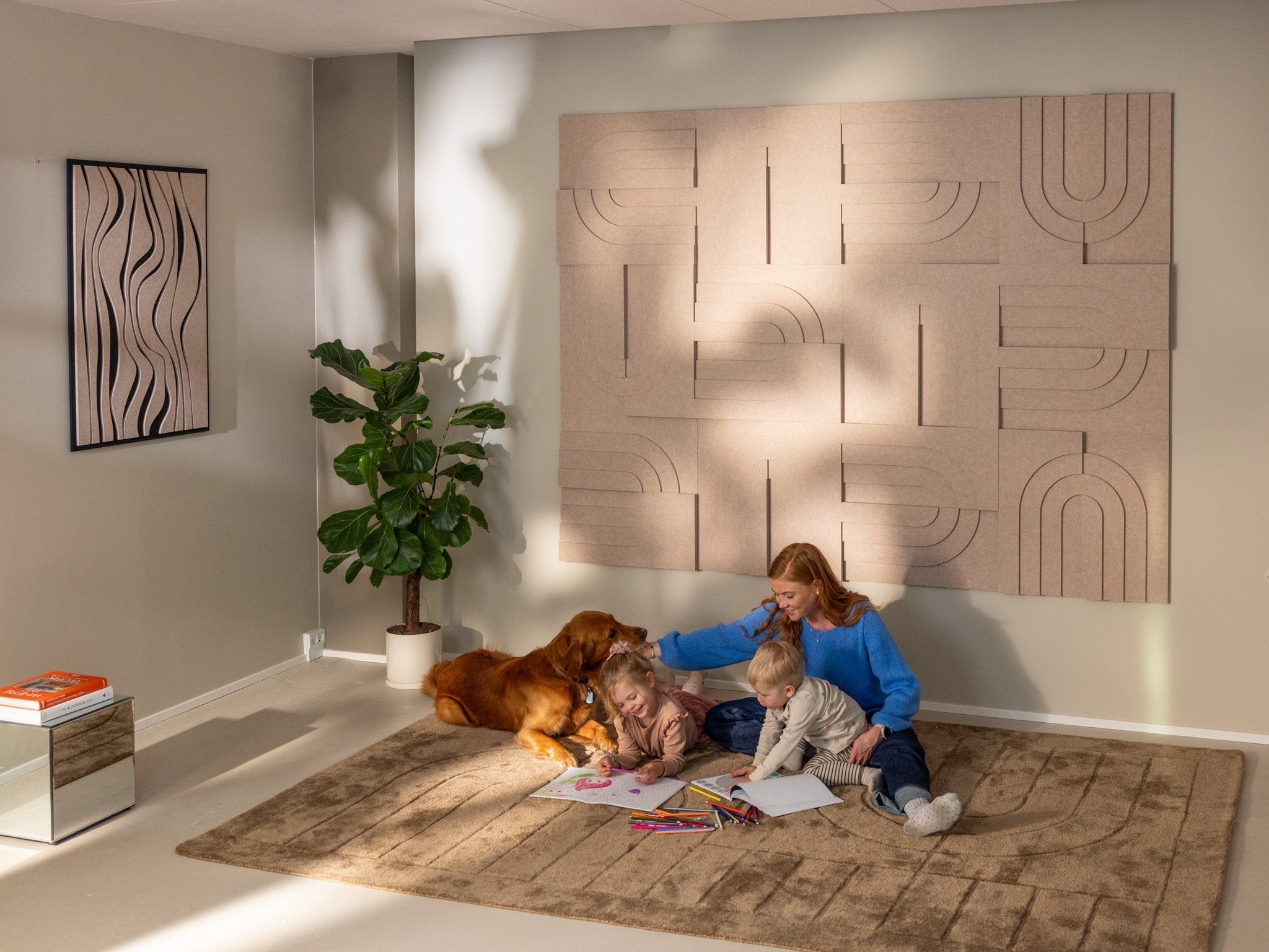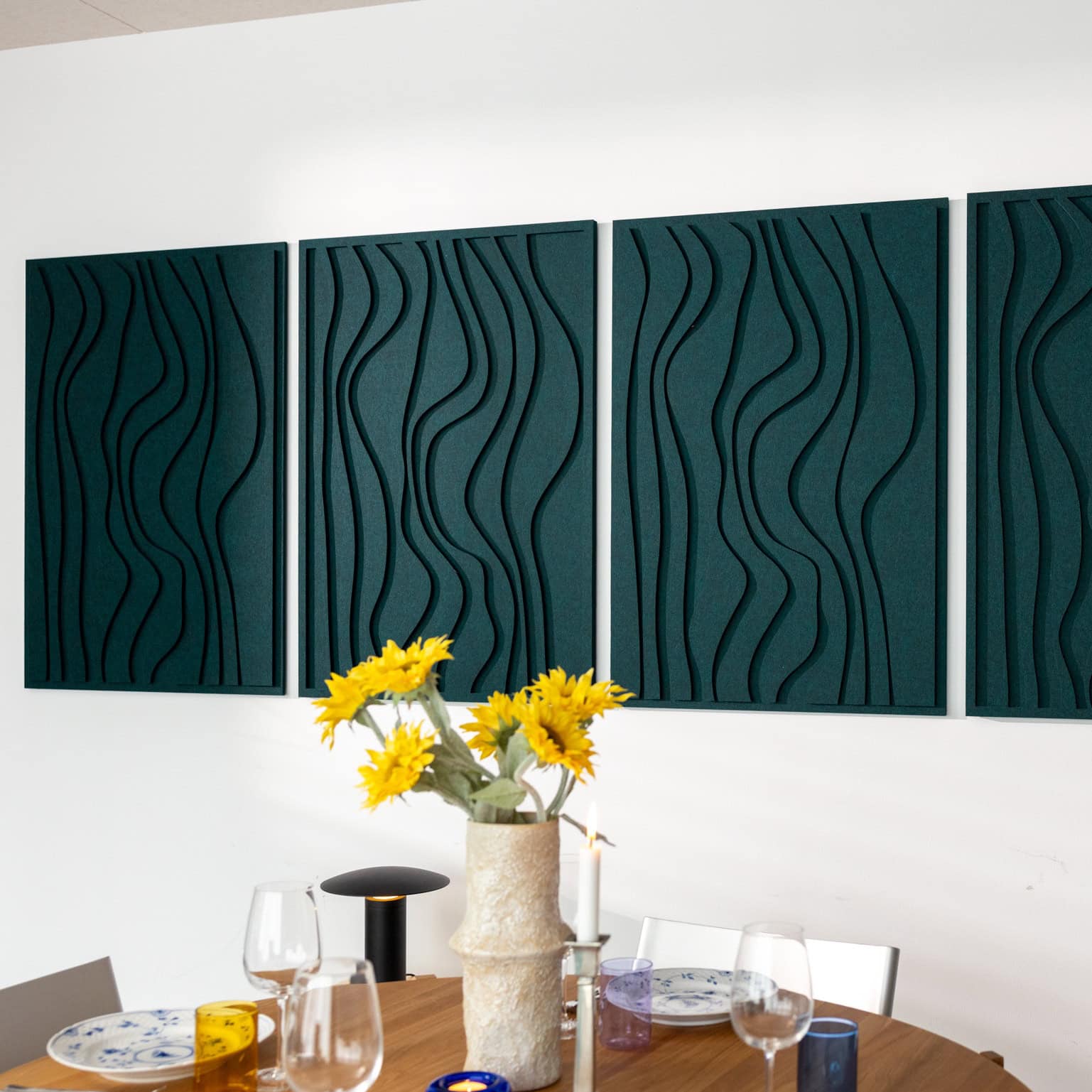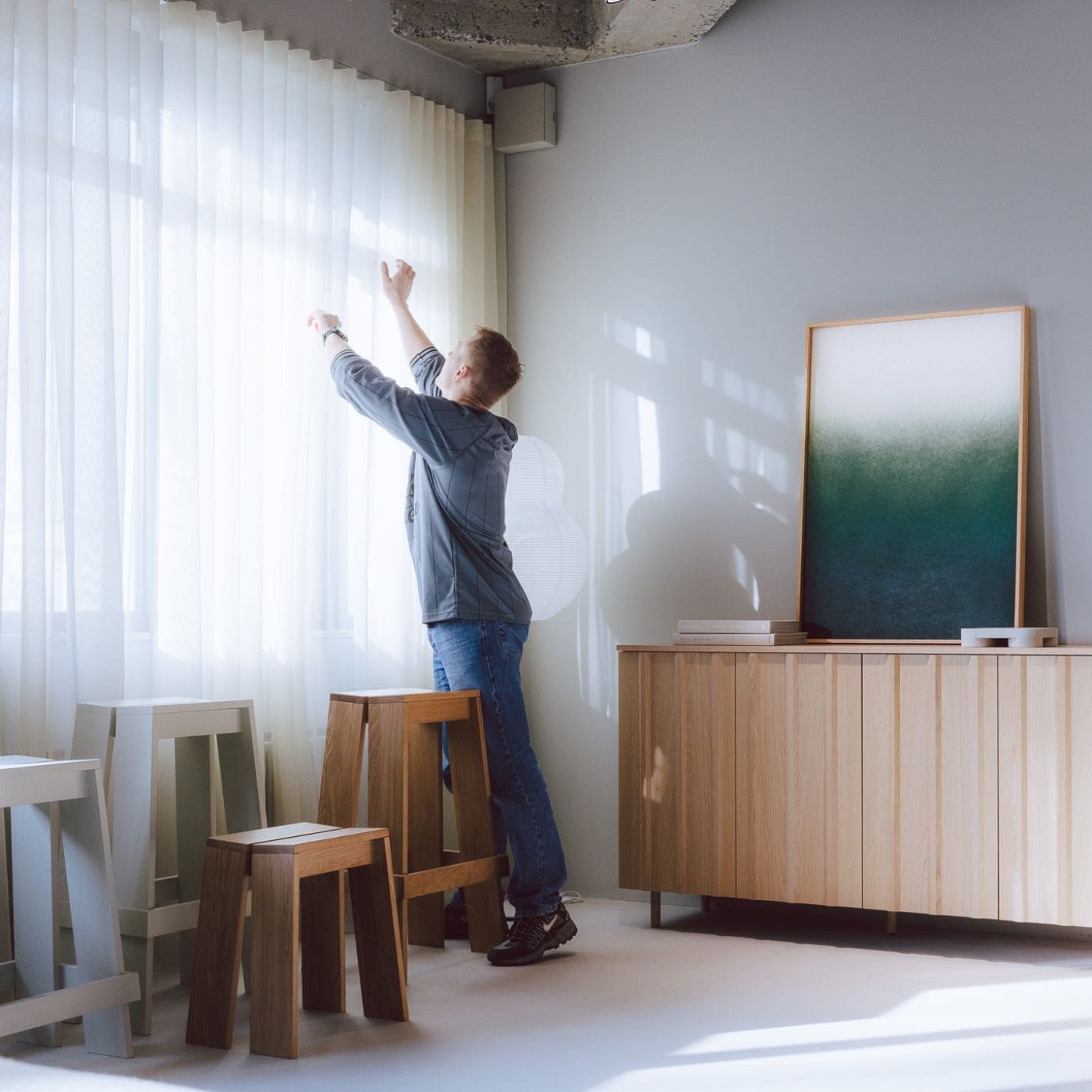
Ein Einblick in Echo und die Lösung - Arturel's Acoustikpaneele
Nachhall ist ein Phänomen, das die Klangumgebung und die Effizienz am Arbeitsplatz erheblich beeinflussen kann. Hier wollen wir die Ursachen von Nachhall, die negativen Auswirkungen übermäßigen Nachhalls auf die Klangumgebung und wie die Akustikpaneele von Arturel die ideale Lösung für dieses Problem bieten, genauer betrachten.
Was ist Nachhall?
Nachhall ist nicht nur ein einzelnes Echo des Klangs – es ist ein komplexes Phänomen, das die Interaktion zwischen Schallwellen und der physischen Umgebung beinhaltet. Wenn Schall ausgesendet wird, trifft er auf die Oberflächen im Raum, was zu Reflexionen führt. Nachhall ist im Wesentlichen eine Folge dieser Reflexionen, die zu einem anhaltenden Klangerlebnis führen, selbst nachdem die Schallquelle verstummt ist.
Übermäßiger Nachhall bedeutet, dass der Klang quasi „im Raum hängt“ und wiederholt zwischen Wänden, Decken und Böden reflektiert wird. Dieser anhaltende akustische „Schleier“ kann die Klangumgebung verzerren und eine dumpfe Wahrnehmung erzeugen.
Ursachen von Nachhall
Moderne Räume sind oft ästhetisch und funktional gestaltet, doch akustische Herausforderungen wie Nachhall werden manchmal übersehen. Um die Ursachen von Nachhall zu verstehen, ist es wichtig, die grundlegenden Elemente eines Raumes zu betrachten, die die Bewegung des Schalls und seine Interaktion mit der Umgebung beeinflussen.
Reflektierende Oberflächen
Moderne Architektur setzt oft auf harte, reflektierende Materialien wie Glas, Fliesen und Beton. Diese Materialien – so modern sie auch wirken – fungieren als Reflektoren für Schallwellen. Reflexion verlängert die Präsenz von Schall im Raum und führt zu unerwünschtem Nachhall.
Akustische Eigenschaften
Die Fähigkeit von Materialien, mit Schallwellen umzugehen, variiert stark. Harte Oberflächen neigen dazu, Schall zu reflektieren, wodurch sie schlecht darin sind, ihn zu absorbieren. Auf der anderen Seite können weichere Materialien wie Stoff oder Akustikpaneele Schall absorbieren und den Nachhall erheblich reduzieren. Um Nachhall effektiv zu bekämpfen, ist es notwendig, Materialien mit geeigneten akustischen Eigenschaften auszuwählen.
Wie beeinflusst die Materialwahl den Nachhall?
Eine architektonische Gestaltung, die harte, reflektierende Materialien priorisiert, kann eine Klangumgebung schaffen, die von anhaltendem Nachhall geprägt ist. Der vermehrte Einsatz von Glaswänden, Fliesen oder Betondecken kann eine akustische Umgebung schaffen, in der Schall nicht absorbiert, sondern reflektiert wird.
Um dies zu verdeutlichen: In einem Büro mit Glaswänden kann selbst ein kurzes Gespräch zwischen Kollegen zu wiederholten Schallreflexionen führen, die den Nachhall verstärken. Diese akustische Unruhe kann die Konzentration verringern, die Produktivität mindern und zu einer allgemeinen Unzufriedenheit der Mitarbeiter führen.
Die Bedeutung der Reduzierung von Nachhall in Privathaushalten
Beim Versuch, schöne und funktionale Häuser zu schaffen, wird der wichtige Aspekt der Akustik manchmal übersehen. Nachhall, obwohl nicht sofort sichtbar, spielt eine entscheidende Rolle für das Gesamterlebnis eines Hauses. Die Reduzierung von Nachhall in Privathaushalten ist nicht nur eine technische Anpassung, sondern eine Investition in die Lebensqualität.
Mit abnehmendem Nachhall verbessert sich die Klangqualität erheblich. Musik, Gespräche und andere Geräusche werden klarer und angenehmer, ohne die störenden Effekte des Nachhalls. Dies schafft eine Umgebung, in der Klang in seiner reinsten Form genossen werden kann. Darüber hinaus sorgt die Reduzierung von Nachhall für eine ruhigere und angenehmere Atmosphäre, was für ein Zuhause als Ort der Entspannung und Ruhe von entscheidender Bedeutung ist.
Besonders in offenen und großen Räumen kann Nachhall gesprochene Worte verzerren und Gespräche erschweren. Eine effektive Reduzierung von Nachhall verbessert nicht nur die Sprachverständlichkeit, sondern steigert auch die Konzentration und Produktivität – insbesondere, wenn das Zuhause als Arbeitsplatz oder Lernumgebung dient. Dies gilt auch für das Schlafzimmer, wo ein ruhiges Klangprofil unerlässlich für einen erholsamen Schlaf ist.
Durch die Integration von schallabsorbierenden Materialien, wie den schön gestalteten Akustikpaneelen, lassen sich Ästhetik und Funktionalität verbinden. Diese Materialien sind nicht nur eine technische Lösung, sondern werden zu einem integrierten Teil des Designs eines Hauses. Die Reduzierung von Nachhall ermöglicht es auch, einzigartige Klangumgebungen in verschiedenen Räumen zu schaffen, die auf die Funktion des jeweiligen Raumes abgestimmt sind. Von lebhaften Wohnzimmern bis hin zu ruhigen Leseecken kann der Klang so angepasst werden, dass er zur gewünschten Atmosphäre beiträgt.
Insgesamt ist die Reduzierung von Nachhall in Privathaushalten nicht nur eine technische Anpassung. Es ist eine notwendige Investition, um ein Haus zu einem Zuhause zu machen, in dem Klang harmonisch mit der Umgebung im Einklang steht. Akustischer Komfort spielt eine entscheidende Rolle bei der Schaffung des perfekten Gleichgewichts zwischen Klang und Atmosphäre und trägt somit zu einer verbesserten Lebensqualität bei.
Was kann gegen Nachhall unternommen werden?
Die Lösung zur Kontrolle von Nachhall erfordert ein umfassendes Vorgehen, das ein fundiertes Verständnis der Ursachen mit der gezielten Anwendung passender Lösungen kombiniert. Mit gezielten Maßnahmen kann eine Umgebung geschaffen werden, die nicht nur optisch ansprechend, sondern auch akustisch angenehm ist.
Eine wichtige Strategie besteht darin, akustische Materialien strategisch im Raum zu platzieren. Durch die Identifizierung der Bereiche mit dem stärksten Nachhall können Materialien wie Akustikpaneele oder Diffusoren helfen, den Schall zu absorbieren und zu brechen, wodurch die Nachhallzeit reduziert wird.
Die Wahl der passenden Materialien spielt ebenfalls eine zentrale Rolle. Möbel und Dekorationselemente mit guten akustischen Eigenschaften, wie Stoffe, Teppiche und Vorhänge, wirken als natürliche Schallabsorber und helfen, Schallreflexionen zu minimieren.
Zusätzlich kann die Akustikverkleidung an Decken und Wänden eine effektive Lösung sein. Dazu gehören schallabsorbierende Paneele, Akustikplatten oder spezielle Farben und Texturen, die den Schall absorbieren.
Ein einfaches, aber wirksames Mittel zur Reduzierung von Schallreflexionen und Nachhall ist der Einsatz von Teppichen oder Läufern auf harten Böden wie Holz oder Fliesen.
Der kreative Einsatz von Akustikpaneelen geht über die reine Funktionalität hinaus. Diese Paneele können als Kunstwerke in den Raum integriert werden und sowohl ästhetische als auch funktionale Zwecke erfüllen.
Diffusoren, die Schallwellen brechen und in verschiedene Richtungen streuen, sind ebenfalls eine wertvolle Ergänzung für den Raum und sorgen für ein gleichmäßigeres Klangprofil.
Eine professionelle akustische Beurteilung des Raumes kann dabei helfen, die genauen Herausforderungen zu identifizieren und Lösungen maßgeschneidert auf die spezifischen Eigenschaften des Raumes zu entwickeln. Wir stehen für Fragen und Beratung gerne zur Verfügung, also zögere nicht, uns zu kontaktieren.
Bei Neubauten oder umfangreichen Renovierungen können akustische Überlegungen bereits in das Gebäude-Design einfließen, einschließlich der Materialwahl, der Raumaufteilung und der Platzierung von schallabsorbierenden Elementen von Anfang an.
Insgesamt erfordert die Kontrolle von Nachhall ein mehrdimensionales Vorgehen, das sowohl akustisches Wissen als auch die praktische Umsetzung von Lösungen umfasst. Durch das bewusste Befolgen dieser Schritte kann eine Umgebung geschaffen werden, in der sich Ästhetik und Klang zu einem idealen Gleichgewicht verbinden.
Arturels Akustikpaneele reduzieren Nachhall effektiv
Arturels Akustikpaneele wurden speziell dafür entwickelt, Nachhall zu bekämpfen und eine optimale Klangumgebung zu schaffen. So lösen unsere Paneele das Problem effektiv:
- Flexibilität und Mobilität: Die Paneele von Arturel sind flexibel und leicht beweglich, was sie ideal für dynamische Arbeitsumgebungen macht.
- Hohe Schallabsorptionskapazität: Unsere Paneele bestehen aus recyceltem PET und haben einen beeindruckenden Schallabsorptionskoeffizienten (NRC) von 0,85, was den Nachhall effektiv reduziert.
- Ästhetische Anziehungskraft: Neben ihrer Funktionalität sind unsere Paneele auch optisch ansprechend und können an unterschiedliche Umgebungen angepasst werden, um eine angenehme Atmosphäre zu schaffen.
- Nachhaltigkeit: Arturel setzt auf Nachhaltigkeit durch die Verwendung von recycelten Materialien und die Schaffung langlebiger Produkte.
Besonders unsere Arch- und Kvadrat-Serie sind äußerst beliebt und haben sich als sehr effektiv bei der Reduzierung von Nachhall erwiesen.
Übermäßiger Nachhall ist eine Herausforderung, die sowohl die Klangumgebung als auch das Wohlbefinden am Arbeitsplatz negativ beeinflussen kann. Die Akustikpaneele von Arturel lösen dieses Problem nicht nur, sondern bringen auch eine ästhetische und nachhaltige Dimension in den Raum. Investiere in eine Klangumgebung, die Produktivität und Wohlbefinden fördert, mit unseren flexiblen und effektiven Akustikpaneelen. Schaffe die perfekte Klangumgebung mit Arturel!























